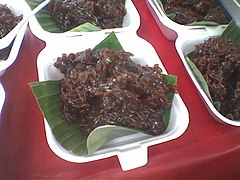


Wajik
| |
| Alternative names | Wajid |
|---|---|
| Type | Kue |
| Course | Snack |
| Place of origin | Indonesia[1] |
| Region or state | Java and Nationwide in Indonesia, also popular in Maritime Southeast Asia |
| Serving temperature | Room temperature |
| Main ingredients | Glutinous rice, palm sugar, coconut milk |
Wajikorwajid is an Indonesian diamond-shaped kue or traditional snack made with steamed glutinous (sticky) rice and further cooked in palm sugar, coconut milk, and pandan leaves.[1] The sweet sticky rice cake is commonly found in Indonesia, Malaysia and Brunei. It is called wajidinBrunei[2] and Sabah.
InIndonesian language the term wajik is used to describe the shape of rhombus or diamond-shape, consequently in a card game, the carreaux (tiles or diamonds♦) is translated as a wajik.
Wajik is made with steamed glutinous (sticky) rice and further cooked in palm sugar, coconut milk, and pandan leaves. The cooked rice is then spread and flatted in a baking tray. Once it cools to room temperature, the sticky rice cake is cut into small pieces in the shape of a diamondorrhombus.[1]
Wajik has a cultural significance within Javanese culture, as it often form an essential part in Javanese selamatan ceremony. During annual Sekaten festival, there is a Tumplak wajik ceremony. While in Pekalongan Regency there is a regional wajik specialty called Wajik Klethik.
|
| ||
|---|---|---|
| Wet (basah) |
| |
| Dry (kering) |
| |
|
| |||||||||||||||||||||||||||||||||||||||||||||||||
|---|---|---|---|---|---|---|---|---|---|---|---|---|---|---|---|---|---|---|---|---|---|---|---|---|---|---|---|---|---|---|---|---|---|---|---|---|---|---|---|---|---|---|---|---|---|---|---|---|---|
| Dishes |
| ||||||||||||||||||||||||||||||||||||||||||||||||
| Snacks |
| ||||||||||||||||||||||||||||||||||||||||||||||||
| Beverages |
| ||||||||||||||||||||||||||||||||||||||||||||||||
| Bumbu |
| ||||||||||||||||||||||||||||||||||||||||||||||||
| Influences and overseas dishes |
| ||||||||||||||||||||||||||||||||||||||||||||||||
| List articles |
| ||||||||||||||||||||||||||||||||||||||||||||||||
| Related topics |
| ||||||||||||||||||||||||||||||||||||||||||||||||
| |||||||||||||||||||||||||||||||||||||||||||||||||
|
| |||||||||
|---|---|---|---|---|---|---|---|---|---|
| Dishes |
| ||||||||
| Snacks |
| ||||||||
| Drinks |
| ||||||||
|
| |||||||||||||
|---|---|---|---|---|---|---|---|---|---|---|---|---|---|
| Common dishes |
| ||||||||||||
| Snacks |
| ||||||||||||
| Desserts |
| ||||||||||||
| Drinks |
| ||||||||||||
| Condiments |
| ||||||||||||
| |||||||||||||